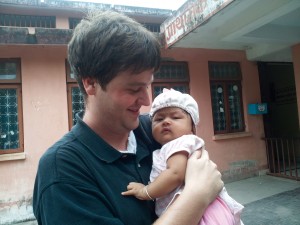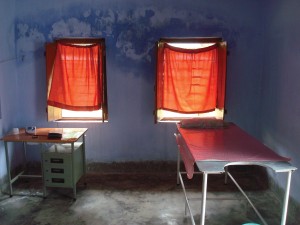For Biomedical Engineering students working in the world’s poorest regions, necessity is the mother of invention.
Related Stories:
» A Promising Partnership
» Making the Rounds
» Video: Antenatal Screening Kit
When Creighton Petty, a student in biomedical engineering at the Whiting School of Engineering, visited Ethiopia last summer as part of his yearlong master’s program, he thought he had prepared himself mentally for the challenges facing the country’s health care workers.

He had traveled extensively through Guatemala and Peru as an undergraduate, and he had seen the constraints of poverty. Still, the lack of resources in the African country startled him—rolling electricity blackouts in hospitals, overcrowded waiting rooms packed with patients, shortages of essential medical supplies.
At a top health outpost, for example, health care workers struggled to provide even the most basic care under dire conditions. “Most posts don’t have water or power because they are made of trees and mud. This one had a water heater and a sink,” Petty wrote, in the team’s daily blog. “But there was one problem: It wasn’t connected to electric or water sources, so many of the features were unusable.”
In a nearby hospital, Ethiopian administrators were trying to make sense of 1,000 different pieces of donated medical equipment, manufactured by 300 companies, made in 22 countries—without any repair manuals. “When you explain to a hospital administrator that you are an engineer,” says Petty, “they automatically think you can fix all this broken equipment. But in many of these countries, the problems are much, much larger.”
Petty and 15 other Hopkins master’s students were in Ethiopia, Tanzania, India, and Nepal as part of their course work at the Johns Hopkins Center for Bioengineering Innovation & Design (CBID), an outgrowth of the Department of Biomedical Engineering’s undergraduate medical device design program developed by faculty members Artin Shoukas and Bob Allen. The yearlong MSE program, which runs from June through May, includes an eight-week rotation with doctors at Johns Hopkins Hospital (see Making the Rounds) as well as a summer trip abroad to understand the health care needs of developing countries.
Now back stateside, the students are working in teams throughout the year to invent a handful of medical devices for markets in both the developed world and in developing nations.
Today, U.S. companies dominate the $350 billion global medical device industry, but that trend is shifting to emerging markets. Medical innovators are turning to value-driven engineering, or frugal engineering, to help meet the staggering burden of care for the world’s poorest—and often sickest—people.
In May 2011, CBID further strengthened its global health initiative by entering a new partnership with the Baltimore-based Jhpiego, a Hopkins affiliate, and the Norwegian nonprofit Laerdal Global Health. The alliance is aimed at tackling health problems facing mothers and newborns in the first hours of life (see A Promising Partnership).
“You cannot be a true leader unless you innovate for the world,” says CBID’s graduate program director, Soumyadipta Acharya. “That means getting out of your U.S. comfort zone and thinking about the very large unmet clinical and public health needs that result in millions of deaths each year.”

When Petty and fellow students fanned out across Tanzania, Ethiopia, India, and Nepal, they were jolted into an immediate understanding of the differing needs in developing countries. “You couldn’t help but be shocked,” says Lauren Smith, who traveled to Ethiopia.
In Tanzania, for example, the largest health care facility in Dar es Salaam was admitting between 1,000 and 1,200 patients daily. Its two OB-GYN surgical units handled as many as 20 to 28 surgeries each day.
“We were surprised to learn that there are between 70 and 100 births per day at this facility,” wrote Luke Jungles, in his team blog from Tanzania. “One nurse helped to deliver more than 600 babies in three months. We also found out that sometimes up to three pregnant women have to share a single bed.”
But beds were not the only resource in short supply. The students noted a lack of reliable electricity, inadequate methods to clean or sterilize equipment, enormous piles of broken devices, a lack of basic diagnostic care, inadequate waste disposal methods, and widespread shortages of basic medicine. In rural areas, students honed in on the need for simple, easy-to-use diagnostic kits for everything from anemia to cervical cancer to infant jaundice. With doctors in short supply, many countries are “task shifting,” or moving the responsibility for general health care to nurses, midwives, clinical officers—even volunteers. The engineering challenge is to design tests that are easy to use but provide enough valuable information to enable users to decide whether patients need a higher level of care.
In many countries, for example, women do not give birth in hospitals. A key problem is determining whether an expectant mother is experiencing serious complications, such as obstructed labor, which can be fatal. Jhpiego estimates that 380,000 women die from pregnancy complications and childbirth each year; 4 million newborns die in their first month; and more than 95 percent of stillborn births occur in developing countries.
In India, students observed the need for treatment of postpartum hemorrhage especially. Says Harshad Sanghvi, Jhpiego’s medical director: “Postpartum hemorrhage doesn’t occur often. But when it does, it kills.” Marton Varady, in his team’s India blog, wrote: “Often the hemorrhage starts at a peripheral hospital, where doctors are unable to control it. At that point, the mother only has about two hours or so before the hemorrhaging has to be stopped; this leads to as many as half the mothers dying in transit.”




